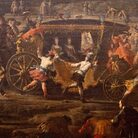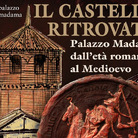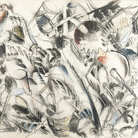Joanna Malinowska and C.T. Jasper. 18°48’05”N 72°23’01”W

© Zachęta – National Gallery of Art |
Dal 9 May 2015 al 22 November 2015
Venezia
Luogo: Biennale / Pad. Polonia
Indirizzo: Biennale Arsenale
Curatori: Magdalena Moskalewicz
E-Mail info: info@labiennale.org
Sito ufficiale: http://www.labiennale.org/
Do the nineteenth century artistic forms still have the power to represent national identity? Is opera today just a cultural anachronism, a sublimated form of leisure, a medium which, as Slavoj Žižek asserts, has already died twice over, and it would be naïve to believe in its radical potential?
There are the questions that the artists Joanna Malinowska and C.T. Jasper, along with curator Magdalena Moskalewicz, have asked themselves as they decided to travel to Haiti in order to show Stanisław Moniuszko’s opera Halkato the descendants of the Polish soldiers from Napoleon’s legions. Sent by Napoleon to San Domingo in the years 1802 and 1803 in order to fight the rebellion of the black slaves, the Poles – who joined the legions to fight for independence of their own occupied homeland – decided to help the insurgents. Their shared endeavours led to the creation of an independent Haiti. Forty-five years after the Haitian uprising, Halka was performed for the first time in Vilnius. The opera’s Polish-language libretto together with strong folk themes expressed the composer’s patriotic gesture in support of his still-occupied motherland.
The authors of the project are interested in what can happen when a community that identifies with Poland on a very general and symbolic level is confronted with a product of the culture that drew their forefathers to Haiti. Moreover, can opera – historically one of the elements of cultural domination exercised by the European empires – play the role of a mediating platform?
Malinowska and Jasper are inspired by a madman’s odyssey of the eponymous hero of Werner Herzog’s “Fitzcarraldo”, who, convinced beyond any doubt of the benevolent, universal and enlightening force of the opera, embarked on improbable quest to bring opera to the inhabitants of the Amazon. At the same time, the artists are aware that Fitzcarraldo’s insanity is romanticized and his quest is enabled by an uneven, colonial distribution of power. Malinowska and Jasper undertake the demystification of the myth of this romantic hero by, paradoxically, realizing his almost delirious plan in a very specific geographic, historical, and socio-economic reality.
Joanna Malinowska is a graduate of the sculpture departments of Rutgers and Yale universities. In her work, Malinowska fluctuates between different media – sculpture, video and performance activities – exploring her interests in anthropology, cultural clashes and music. Since 2001, she has been represented by Canada gallery in New York. Malinowska’s works have been shown in such venues as the Sculpture Center, Art in General and Postmasters in New York, the Saatchi Gallery and Nottingham Contemporary in Great Britain, the Espace Culturel Louis Vuitton in Paris, CSW Zamek Ujazdowski and Zachęta – National Gallery of Art in Warsaw. She participated in the First Moscow Art Biennial and the Whitney Biennial 2012 in New York. She has received grants from the John Simon Guggenheim Foundation, the Pollock-Krasner Foundation, the New York Foundation for the Arts, the Ministry of Culture and National Heritage and Smack Mellon.
C. T. Jasper splits his life between New York and Ulan Bator. His works oscillate on a threshold of different media, concentrating principally on video and electronic-partisan interventions in already existing film works. Jasper’s most recent projects include Erased (2013) – exhibited at the Warsaw Gallery Le Guern and The Standard in Los Angeles – and Sunset of the Pharaohspresented at the Frieze Focus’14 in New York. His projects have been presented in numerous exhibitions in North America and Europe.
Magdalena Moskalewicz is A. W. Mellon Postdoctoral Fellow at the Museum of Modern Art (MoMA) in New York, where she leads a research group focusing on postwar experimental art from Central and Eastern Europe. Together with curators, librarians, and archivists, she works on broadening the scope of museum’s collections, exhibitions and education programs beyond the western canon as a part of MoMA’s research initiative C-MAP (Contemporary and Modern Art Perspectives in a Global Age). She also serves as co-editor of the C-MAP’s digital publication platform, post (post.at.moma.org). Magdalena was awarded a doctoral degree in art history from the Adam Mickiewicz University for her research into experiments with painting in Poland in the 1960s. Her research was funded by Andrew W. Mellon Foundation, Kosciuszko Foundation, Adam Mickiewicz University Foundation and the Polish Ministry of Science and Higher Education. Magdalena’s research interests include art of the Eastern European avant-gardes and neo-avantgardes, art of the Cold War era as well as exhibition history. Before she joined MoMA in 2012, she was the editor in chief of Arteon, a monthly magazine on contemporary art.
There are the questions that the artists Joanna Malinowska and C.T. Jasper, along with curator Magdalena Moskalewicz, have asked themselves as they decided to travel to Haiti in order to show Stanisław Moniuszko’s opera Halkato the descendants of the Polish soldiers from Napoleon’s legions. Sent by Napoleon to San Domingo in the years 1802 and 1803 in order to fight the rebellion of the black slaves, the Poles – who joined the legions to fight for independence of their own occupied homeland – decided to help the insurgents. Their shared endeavours led to the creation of an independent Haiti. Forty-five years after the Haitian uprising, Halka was performed for the first time in Vilnius. The opera’s Polish-language libretto together with strong folk themes expressed the composer’s patriotic gesture in support of his still-occupied motherland.
The authors of the project are interested in what can happen when a community that identifies with Poland on a very general and symbolic level is confronted with a product of the culture that drew their forefathers to Haiti. Moreover, can opera – historically one of the elements of cultural domination exercised by the European empires – play the role of a mediating platform?
Malinowska and Jasper are inspired by a madman’s odyssey of the eponymous hero of Werner Herzog’s “Fitzcarraldo”, who, convinced beyond any doubt of the benevolent, universal and enlightening force of the opera, embarked on improbable quest to bring opera to the inhabitants of the Amazon. At the same time, the artists are aware that Fitzcarraldo’s insanity is romanticized and his quest is enabled by an uneven, colonial distribution of power. Malinowska and Jasper undertake the demystification of the myth of this romantic hero by, paradoxically, realizing his almost delirious plan in a very specific geographic, historical, and socio-economic reality.
Joanna Malinowska is a graduate of the sculpture departments of Rutgers and Yale universities. In her work, Malinowska fluctuates between different media – sculpture, video and performance activities – exploring her interests in anthropology, cultural clashes and music. Since 2001, she has been represented by Canada gallery in New York. Malinowska’s works have been shown in such venues as the Sculpture Center, Art in General and Postmasters in New York, the Saatchi Gallery and Nottingham Contemporary in Great Britain, the Espace Culturel Louis Vuitton in Paris, CSW Zamek Ujazdowski and Zachęta – National Gallery of Art in Warsaw. She participated in the First Moscow Art Biennial and the Whitney Biennial 2012 in New York. She has received grants from the John Simon Guggenheim Foundation, the Pollock-Krasner Foundation, the New York Foundation for the Arts, the Ministry of Culture and National Heritage and Smack Mellon.
C. T. Jasper splits his life between New York and Ulan Bator. His works oscillate on a threshold of different media, concentrating principally on video and electronic-partisan interventions in already existing film works. Jasper’s most recent projects include Erased (2013) – exhibited at the Warsaw Gallery Le Guern and The Standard in Los Angeles – and Sunset of the Pharaohspresented at the Frieze Focus’14 in New York. His projects have been presented in numerous exhibitions in North America and Europe.
Magdalena Moskalewicz is A. W. Mellon Postdoctoral Fellow at the Museum of Modern Art (MoMA) in New York, where she leads a research group focusing on postwar experimental art from Central and Eastern Europe. Together with curators, librarians, and archivists, she works on broadening the scope of museum’s collections, exhibitions and education programs beyond the western canon as a part of MoMA’s research initiative C-MAP (Contemporary and Modern Art Perspectives in a Global Age). She also serves as co-editor of the C-MAP’s digital publication platform, post (post.at.moma.org). Magdalena was awarded a doctoral degree in art history from the Adam Mickiewicz University for her research into experiments with painting in Poland in the 1960s. Her research was funded by Andrew W. Mellon Foundation, Kosciuszko Foundation, Adam Mickiewicz University Foundation and the Polish Ministry of Science and Higher Education. Magdalena’s research interests include art of the Eastern European avant-gardes and neo-avantgardes, art of the Cold War era as well as exhibition history. Before she joined MoMA in 2012, she was the editor in chief of Arteon, a monthly magazine on contemporary art.
SCARICA IL COMUNICATO IN PDF
COMMENTI

-
 Dal 20 December 2025 al 20 April 2026
Caserta | Reggia di Caserta
Dal 20 December 2025 al 20 April 2026
Caserta | Reggia di Caserta
Regine: trame di cultura e diplomazia tra Napoli e l’Europa
-
 Dal 19 December 2025 al 23 March 2026
Torino | Palazzo Madama - Museo Civico d’Arte Antica
Dal 19 December 2025 al 23 March 2026
Torino | Palazzo Madama - Museo Civico d’Arte Antica
Il castello ritrovato. Palazzo Madama dall’età romana al medioevo
-
 Dal 17 December 2025 al 19 January 2026
Roma | Palazzo della Cancelleria
Dal 17 December 2025 al 19 January 2026
Roma | Palazzo della Cancelleria
De Humana Mensura di Linda Karshan
-
 Dal 18 December 2025 al 12 April 2026
Firenze | Gallerie degli Uffizi
Dal 18 December 2025 al 12 April 2026
Firenze | Gallerie degli Uffizi
Cera una volta. Sculture dalle collezioni medicee
-
 Dal 11 December 2025 al 9 April 2026
Firenze | Museo Archeologico Nazionale di Firenze
Dal 11 December 2025 al 9 April 2026
Firenze | Museo Archeologico Nazionale di Firenze
Icone di Potere e Bellezza
-
 Dal 11 December 2025 al 11 January 2026
Roma | Palazzo Esposizioni Roma
Dal 11 December 2025 al 11 January 2026
Roma | Palazzo Esposizioni Roma
Giorgio Morandi nella Collezione Eni. Un viaggio attraverso la storia culturale del cane a sei zampe e l’eredità di Enrico Mattei


